NSB203: Distraction's Role in Reducing Procedural Pain in Children
VerifiedAdded on 2022/09/30
|12
|3105
|22
Report
AI Summary
This report provides a comprehensive analysis of distraction techniques used to reduce procedural pain in children. It begins by contrasting quantitative and qualitative research methods, highlighting their differences and similarities in data analysis and reasoning. The report then critically analyzes the contribution of both research approaches to the understanding of distraction as a pain management strategy, discussing various techniques such as distraction cards, music therapy, and balloon inflation. It evaluates the effectiveness of these methods based on available literature. The assignment concludes with a reflection on the learning experience, emphasizing the importance of evidence-based nursing practice and the relevance of distraction techniques in clinical settings. The author discusses the practical implications of the research and its impact on their future nursing practice, including the integration of academic knowledge with clinical practice to enhance patient care and safety.
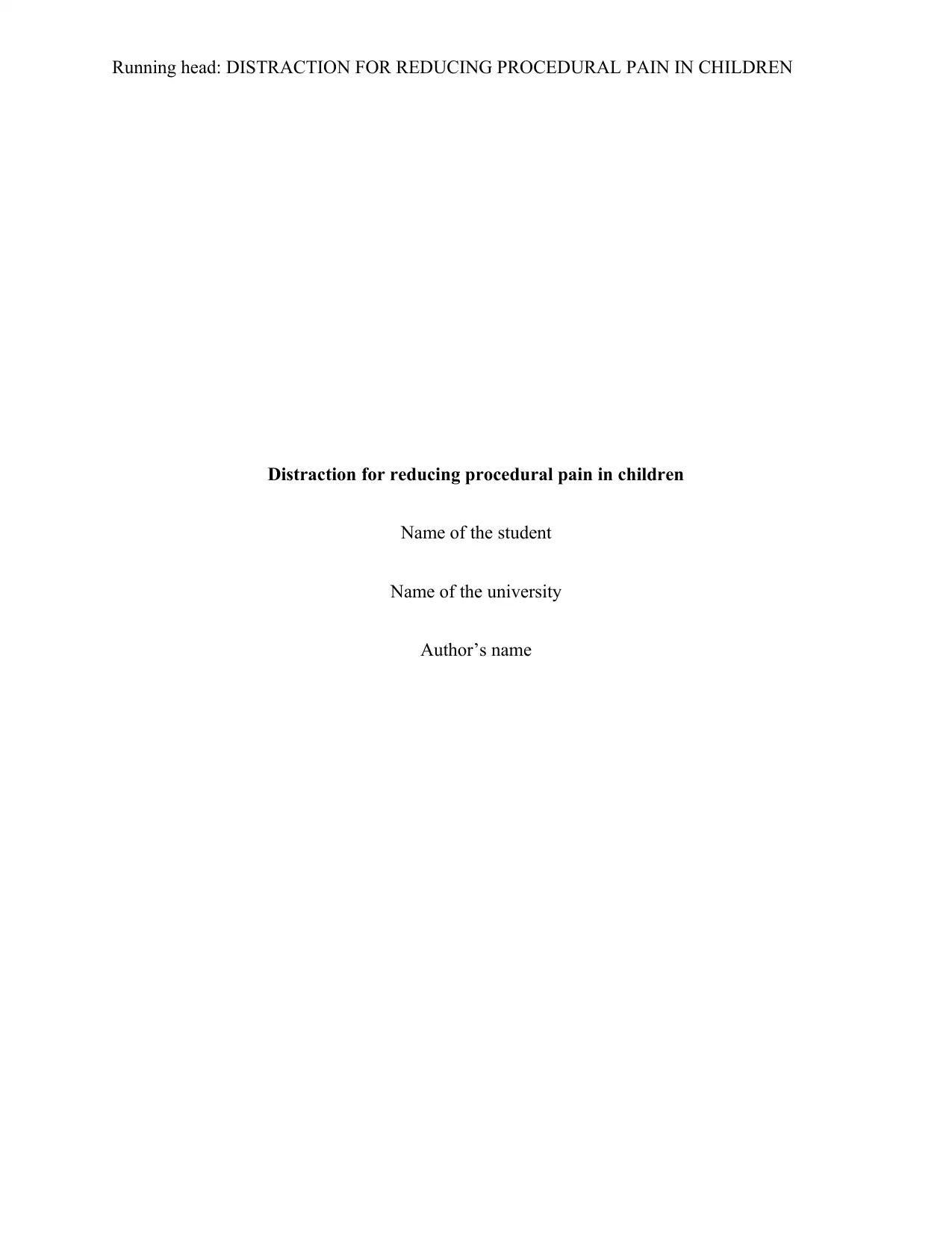
Running head: DISTRACTION FOR REDUCING PROCEDURAL PAIN IN CHILDREN
Distraction for reducing procedural pain in children
Name of the student
Name of the university
Author’s name
Distraction for reducing procedural pain in children
Name of the student
Name of the university
Author’s name
Paraphrase This Document
Need a fresh take? Get an instant paraphrase of this document with our AI Paraphraser
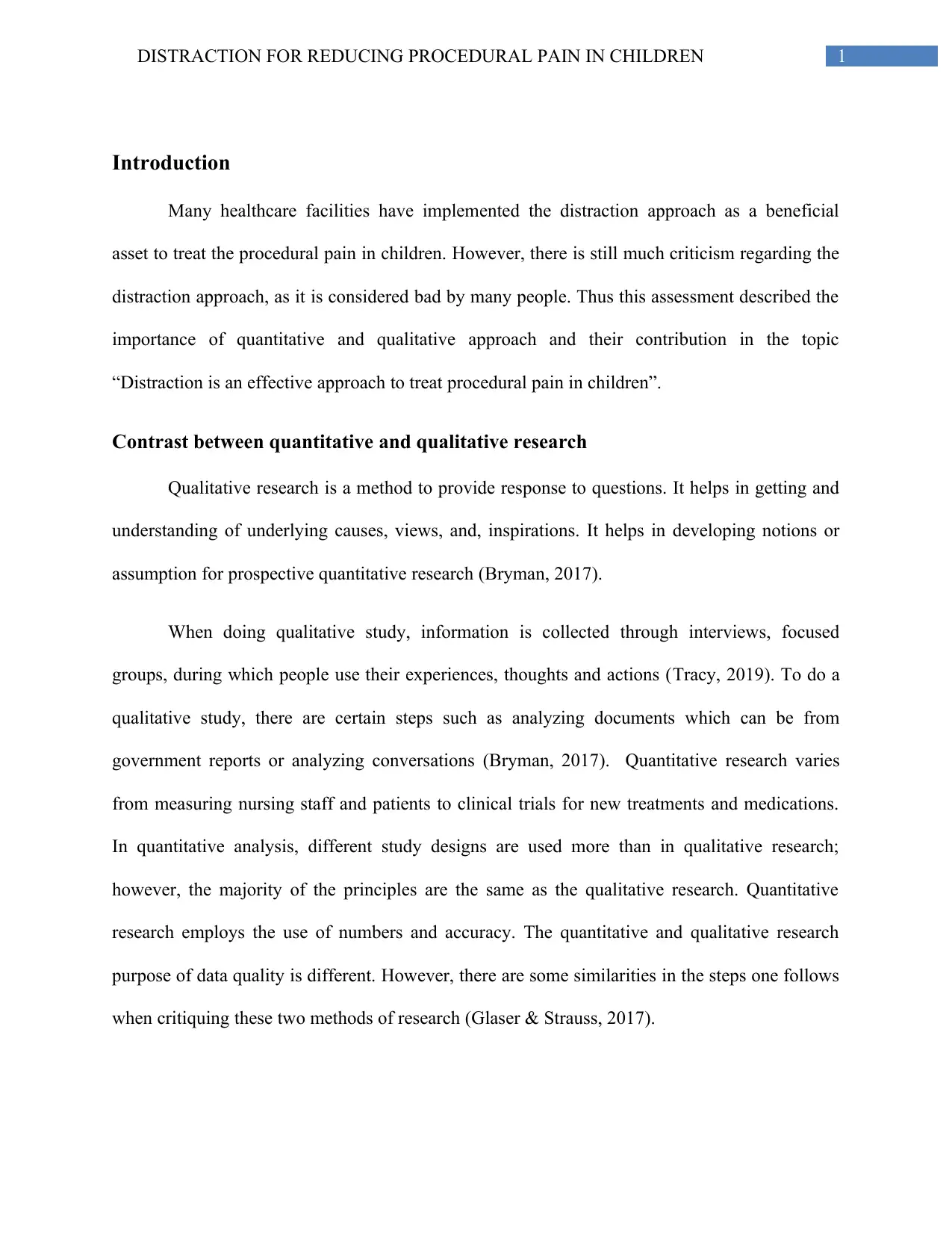
1DISTRACTION FOR REDUCING PROCEDURAL PAIN IN CHILDREN
Introduction
Many healthcare facilities have implemented the distraction approach as a beneficial
asset to treat the procedural pain in children. However, there is still much criticism regarding the
distraction approach, as it is considered bad by many people. Thus this assessment described the
importance of quantitative and qualitative approach and their contribution in the topic
“Distraction is an effective approach to treat procedural pain in children”.
Contrast between quantitative and qualitative research
Qualitative research is a method to provide response to questions. It helps in getting and
understanding of underlying causes, views, and, inspirations. It helps in developing notions or
assumption for prospective quantitative research (Bryman, 2017).
When doing qualitative study, information is collected through interviews, focused
groups, during which people use their experiences, thoughts and actions (Tracy, 2019). To do a
qualitative study, there are certain steps such as analyzing documents which can be from
government reports or analyzing conversations (Bryman, 2017). Quantitative research varies
from measuring nursing staff and patients to clinical trials for new treatments and medications.
In quantitative analysis, different study designs are used more than in qualitative research;
however, the majority of the principles are the same as the qualitative research. Quantitative
research employs the use of numbers and accuracy. The quantitative and qualitative research
purpose of data quality is different. However, there are some similarities in the steps one follows
when critiquing these two methods of research (Glaser & Strauss, 2017).
Introduction
Many healthcare facilities have implemented the distraction approach as a beneficial
asset to treat the procedural pain in children. However, there is still much criticism regarding the
distraction approach, as it is considered bad by many people. Thus this assessment described the
importance of quantitative and qualitative approach and their contribution in the topic
“Distraction is an effective approach to treat procedural pain in children”.
Contrast between quantitative and qualitative research
Qualitative research is a method to provide response to questions. It helps in getting and
understanding of underlying causes, views, and, inspirations. It helps in developing notions or
assumption for prospective quantitative research (Bryman, 2017).
When doing qualitative study, information is collected through interviews, focused
groups, during which people use their experiences, thoughts and actions (Tracy, 2019). To do a
qualitative study, there are certain steps such as analyzing documents which can be from
government reports or analyzing conversations (Bryman, 2017). Quantitative research varies
from measuring nursing staff and patients to clinical trials for new treatments and medications.
In quantitative analysis, different study designs are used more than in qualitative research;
however, the majority of the principles are the same as the qualitative research. Quantitative
research employs the use of numbers and accuracy. The quantitative and qualitative research
purpose of data quality is different. However, there are some similarities in the steps one follows
when critiquing these two methods of research (Glaser & Strauss, 2017).
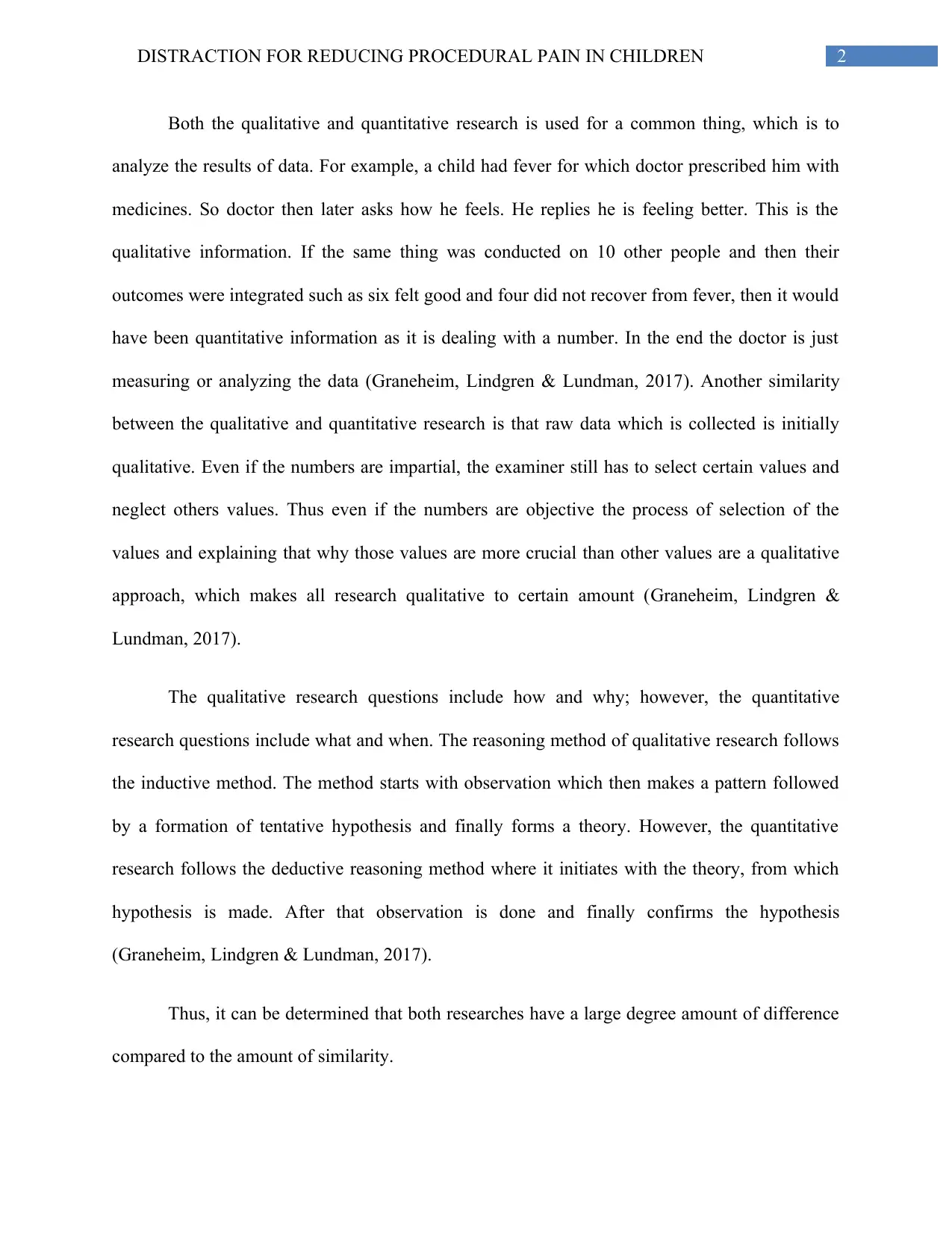
2DISTRACTION FOR REDUCING PROCEDURAL PAIN IN CHILDREN
Both the qualitative and quantitative research is used for a common thing, which is to
analyze the results of data. For example, a child had fever for which doctor prescribed him with
medicines. So doctor then later asks how he feels. He replies he is feeling better. This is the
qualitative information. If the same thing was conducted on 10 other people and then their
outcomes were integrated such as six felt good and four did not recover from fever, then it would
have been quantitative information as it is dealing with a number. In the end the doctor is just
measuring or analyzing the data (Graneheim, Lindgren & Lundman, 2017). Another similarity
between the qualitative and quantitative research is that raw data which is collected is initially
qualitative. Even if the numbers are impartial, the examiner still has to select certain values and
neglect others values. Thus even if the numbers are objective the process of selection of the
values and explaining that why those values are more crucial than other values are a qualitative
approach, which makes all research qualitative to certain amount (Graneheim, Lindgren &
Lundman, 2017).
The qualitative research questions include how and why; however, the quantitative
research questions include what and when. The reasoning method of qualitative research follows
the inductive method. The method starts with observation which then makes a pattern followed
by a formation of tentative hypothesis and finally forms a theory. However, the quantitative
research follows the deductive reasoning method where it initiates with the theory, from which
hypothesis is made. After that observation is done and finally confirms the hypothesis
(Graneheim, Lindgren & Lundman, 2017).
Thus, it can be determined that both researches have a large degree amount of difference
compared to the amount of similarity.
Both the qualitative and quantitative research is used for a common thing, which is to
analyze the results of data. For example, a child had fever for which doctor prescribed him with
medicines. So doctor then later asks how he feels. He replies he is feeling better. This is the
qualitative information. If the same thing was conducted on 10 other people and then their
outcomes were integrated such as six felt good and four did not recover from fever, then it would
have been quantitative information as it is dealing with a number. In the end the doctor is just
measuring or analyzing the data (Graneheim, Lindgren & Lundman, 2017). Another similarity
between the qualitative and quantitative research is that raw data which is collected is initially
qualitative. Even if the numbers are impartial, the examiner still has to select certain values and
neglect others values. Thus even if the numbers are objective the process of selection of the
values and explaining that why those values are more crucial than other values are a qualitative
approach, which makes all research qualitative to certain amount (Graneheim, Lindgren &
Lundman, 2017).
The qualitative research questions include how and why; however, the quantitative
research questions include what and when. The reasoning method of qualitative research follows
the inductive method. The method starts with observation which then makes a pattern followed
by a formation of tentative hypothesis and finally forms a theory. However, the quantitative
research follows the deductive reasoning method where it initiates with the theory, from which
hypothesis is made. After that observation is done and finally confirms the hypothesis
(Graneheim, Lindgren & Lundman, 2017).
Thus, it can be determined that both researches have a large degree amount of difference
compared to the amount of similarity.
⊘ This is a preview!⊘
Do you want full access?
Subscribe today to unlock all pages.

Trusted by 1+ million students worldwide

3DISTRACTION FOR REDUCING PROCEDURAL PAIN IN CHILDREN
Paraphrase This Document
Need a fresh take? Get an instant paraphrase of this document with our AI Paraphraser
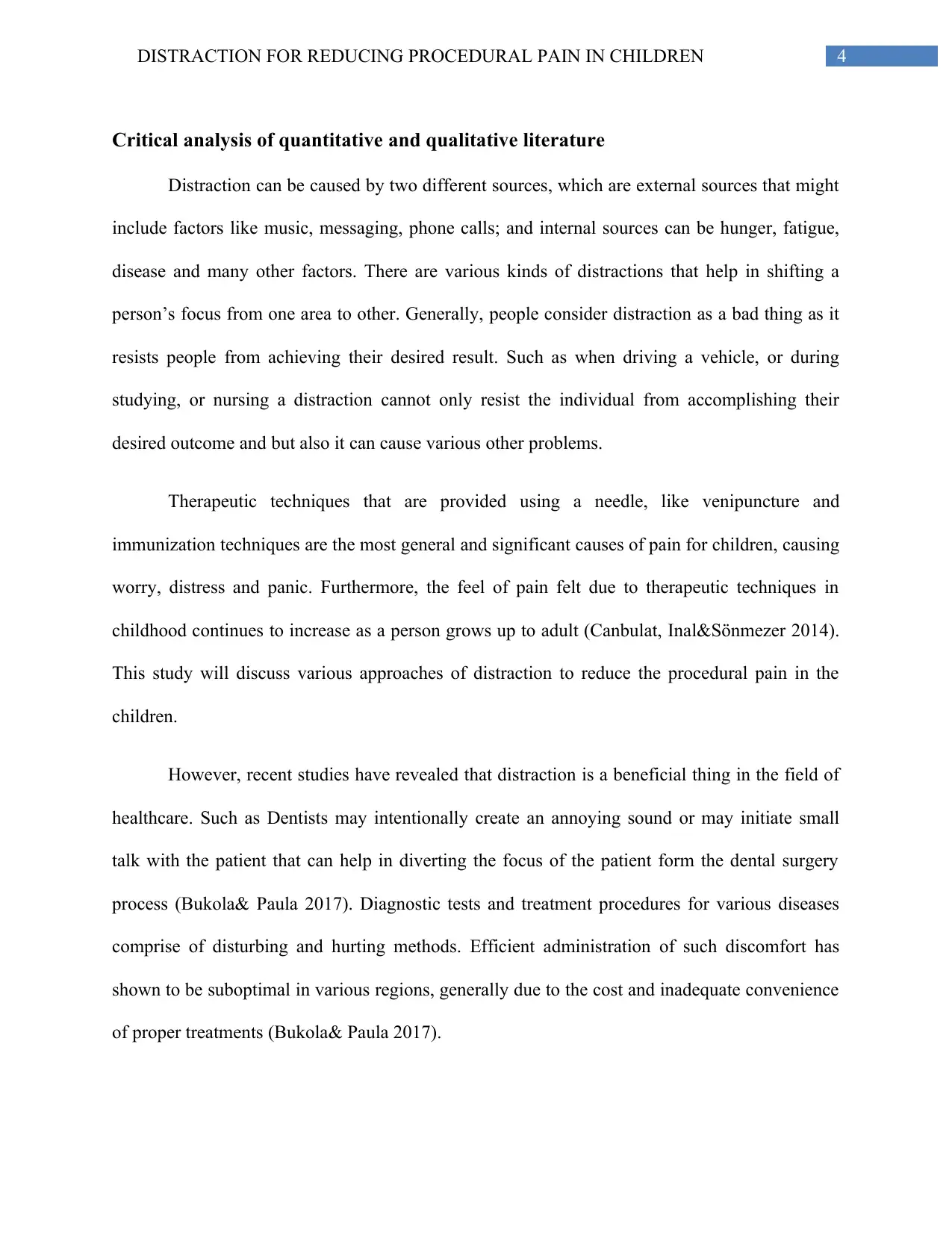
4DISTRACTION FOR REDUCING PROCEDURAL PAIN IN CHILDREN
Critical analysis of quantitative and qualitative literature
Distraction can be caused by two different sources, which are external sources that might
include factors like music, messaging, phone calls; and internal sources can be hunger, fatigue,
disease and many other factors. There are various kinds of distractions that help in shifting a
person’s focus from one area to other. Generally, people consider distraction as a bad thing as it
resists people from achieving their desired result. Such as when driving a vehicle, or during
studying, or nursing a distraction cannot only resist the individual from accomplishing their
desired outcome and but also it can cause various other problems.
Therapeutic techniques that are provided using a needle, like venipuncture and
immunization techniques are the most general and significant causes of pain for children, causing
worry, distress and panic. Furthermore, the feel of pain felt due to therapeutic techniques in
childhood continues to increase as a person grows up to adult (Canbulat, Inal&Sönmezer 2014).
This study will discuss various approaches of distraction to reduce the procedural pain in the
children.
However, recent studies have revealed that distraction is a beneficial thing in the field of
healthcare. Such as Dentists may intentionally create an annoying sound or may initiate small
talk with the patient that can help in diverting the focus of the patient form the dental surgery
process (Bukola& Paula 2017). Diagnostic tests and treatment procedures for various diseases
comprise of disturbing and hurting methods. Efficient administration of such discomfort has
shown to be suboptimal in various regions, generally due to the cost and inadequate convenience
of proper treatments (Bukola& Paula 2017).
Critical analysis of quantitative and qualitative literature
Distraction can be caused by two different sources, which are external sources that might
include factors like music, messaging, phone calls; and internal sources can be hunger, fatigue,
disease and many other factors. There are various kinds of distractions that help in shifting a
person’s focus from one area to other. Generally, people consider distraction as a bad thing as it
resists people from achieving their desired result. Such as when driving a vehicle, or during
studying, or nursing a distraction cannot only resist the individual from accomplishing their
desired outcome and but also it can cause various other problems.
Therapeutic techniques that are provided using a needle, like venipuncture and
immunization techniques are the most general and significant causes of pain for children, causing
worry, distress and panic. Furthermore, the feel of pain felt due to therapeutic techniques in
childhood continues to increase as a person grows up to adult (Canbulat, Inal&Sönmezer 2014).
This study will discuss various approaches of distraction to reduce the procedural pain in the
children.
However, recent studies have revealed that distraction is a beneficial thing in the field of
healthcare. Such as Dentists may intentionally create an annoying sound or may initiate small
talk with the patient that can help in diverting the focus of the patient form the dental surgery
process (Bukola& Paula 2017). Diagnostic tests and treatment procedures for various diseases
comprise of disturbing and hurting methods. Efficient administration of such discomfort has
shown to be suboptimal in various regions, generally due to the cost and inadequate convenience
of proper treatments (Bukola& Paula 2017).
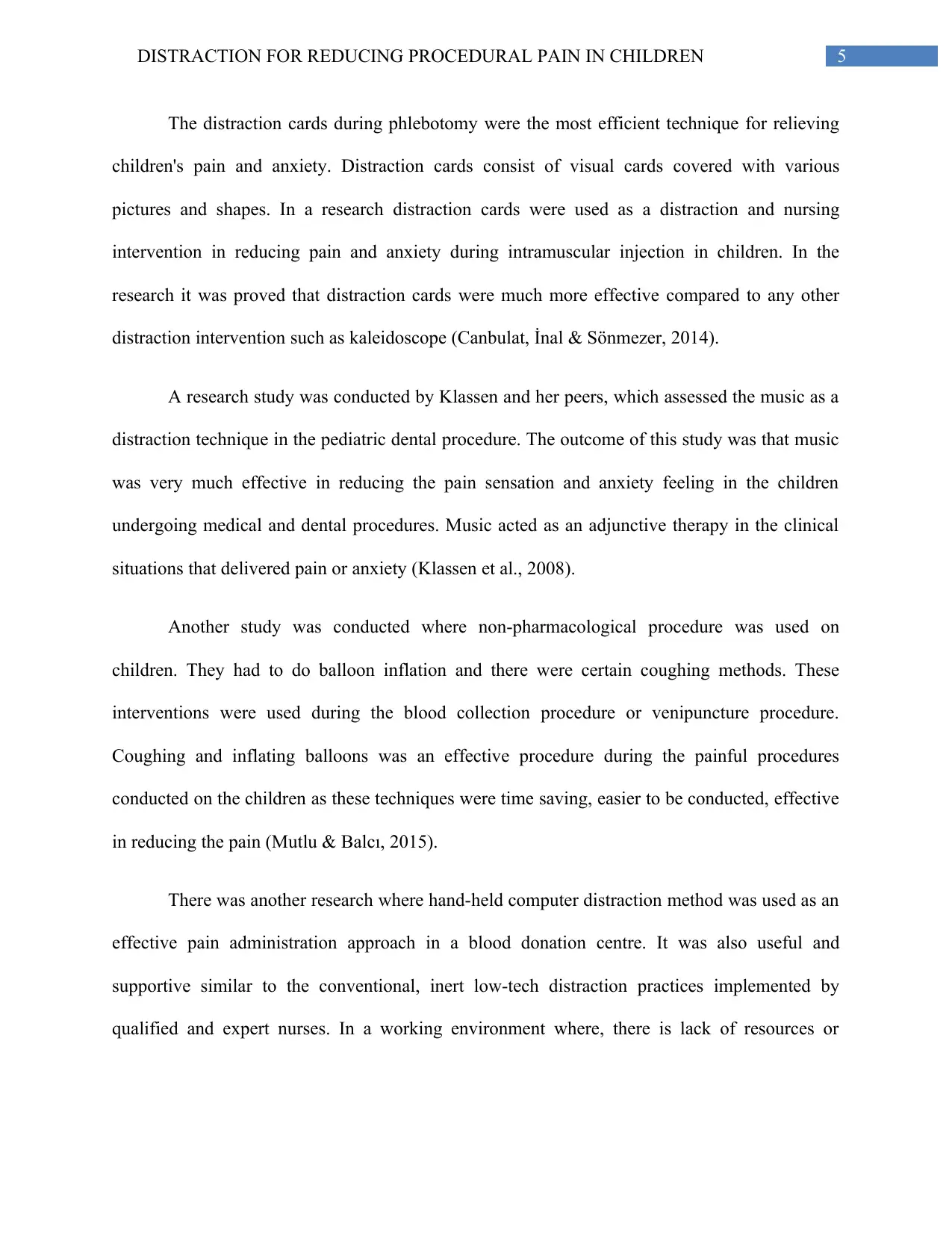
5DISTRACTION FOR REDUCING PROCEDURAL PAIN IN CHILDREN
The distraction cards during phlebotomy were the most efficient technique for relieving
children's pain and anxiety. Distraction cards consist of visual cards covered with various
pictures and shapes. In a research distraction cards were used as a distraction and nursing
intervention in reducing pain and anxiety during intramuscular injection in children. In the
research it was proved that distraction cards were much more effective compared to any other
distraction intervention such as kaleidoscope (Canbulat, İnal & Sönmezer, 2014).
A research study was conducted by Klassen and her peers, which assessed the music as a
distraction technique in the pediatric dental procedure. The outcome of this study was that music
was very much effective in reducing the pain sensation and anxiety feeling in the children
undergoing medical and dental procedures. Music acted as an adjunctive therapy in the clinical
situations that delivered pain or anxiety (Klassen et al., 2008).
Another study was conducted where non-pharmacological procedure was used on
children. They had to do balloon inflation and there were certain coughing methods. These
interventions were used during the blood collection procedure or venipuncture procedure.
Coughing and inflating balloons was an effective procedure during the painful procedures
conducted on the children as these techniques were time saving, easier to be conducted, effective
in reducing the pain (Mutlu & Balcı, 2015).
There was another research where hand-held computer distraction method was used as an
effective pain administration approach in a blood donation centre. It was also useful and
supportive similar to the conventional, inert low-tech distraction practices implemented by
qualified and expert nurses. In a working environment where, there is lack of resources or
The distraction cards during phlebotomy were the most efficient technique for relieving
children's pain and anxiety. Distraction cards consist of visual cards covered with various
pictures and shapes. In a research distraction cards were used as a distraction and nursing
intervention in reducing pain and anxiety during intramuscular injection in children. In the
research it was proved that distraction cards were much more effective compared to any other
distraction intervention such as kaleidoscope (Canbulat, İnal & Sönmezer, 2014).
A research study was conducted by Klassen and her peers, which assessed the music as a
distraction technique in the pediatric dental procedure. The outcome of this study was that music
was very much effective in reducing the pain sensation and anxiety feeling in the children
undergoing medical and dental procedures. Music acted as an adjunctive therapy in the clinical
situations that delivered pain or anxiety (Klassen et al., 2008).
Another study was conducted where non-pharmacological procedure was used on
children. They had to do balloon inflation and there were certain coughing methods. These
interventions were used during the blood collection procedure or venipuncture procedure.
Coughing and inflating balloons was an effective procedure during the painful procedures
conducted on the children as these techniques were time saving, easier to be conducted, effective
in reducing the pain (Mutlu & Balcı, 2015).
There was another research where hand-held computer distraction method was used as an
effective pain administration approach in a blood donation centre. It was also useful and
supportive similar to the conventional, inert low-tech distraction practices implemented by
qualified and expert nurses. In a working environment where, there is lack of resources or
⊘ This is a preview!⊘
Do you want full access?
Subscribe today to unlock all pages.

Trusted by 1+ million students worldwide
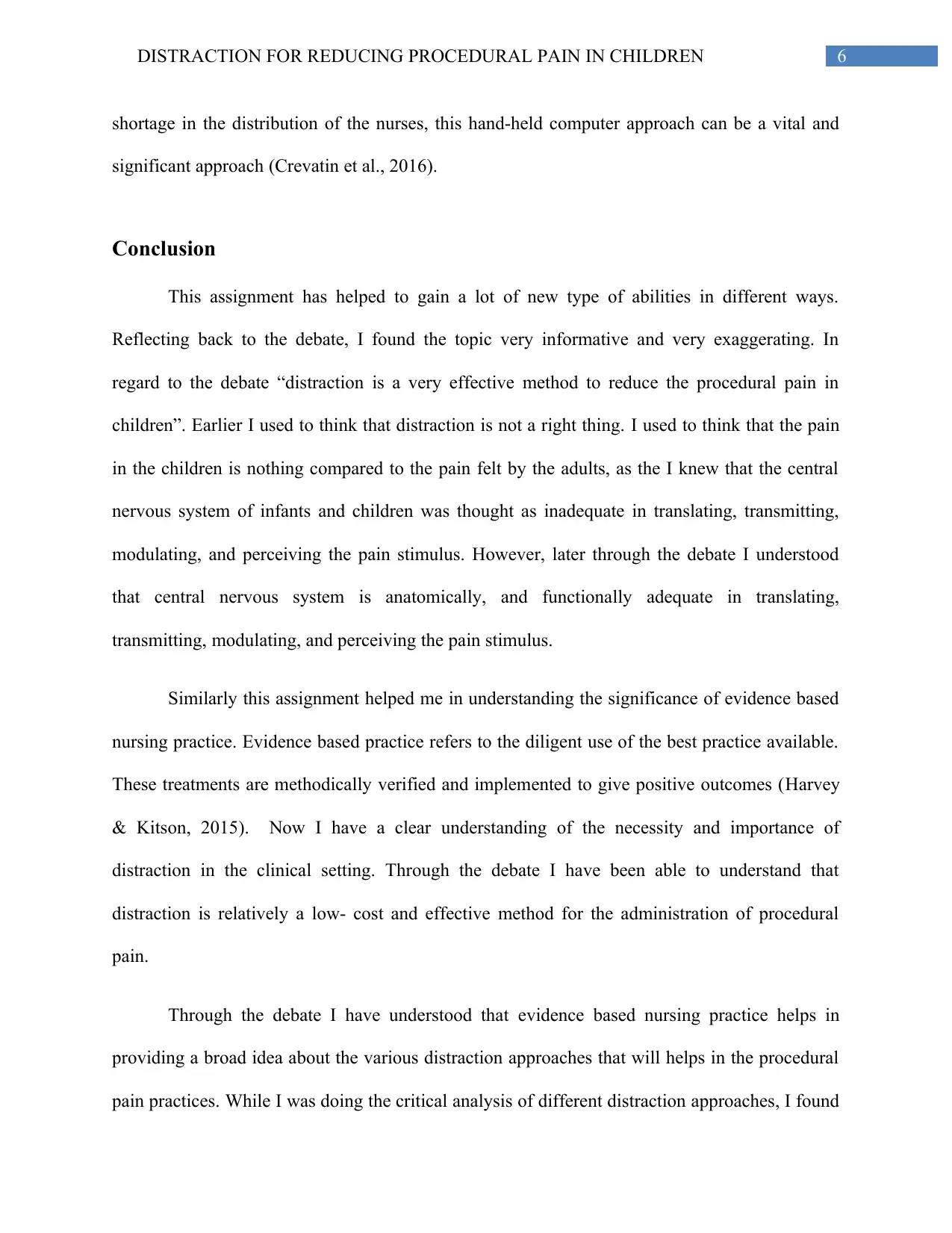
6DISTRACTION FOR REDUCING PROCEDURAL PAIN IN CHILDREN
shortage in the distribution of the nurses, this hand-held computer approach can be a vital and
significant approach (Crevatin et al., 2016).
Conclusion
This assignment has helped to gain a lot of new type of abilities in different ways.
Reflecting back to the debate, I found the topic very informative and very exaggerating. In
regard to the debate “distraction is a very effective method to reduce the procedural pain in
children”. Earlier I used to think that distraction is not a right thing. I used to think that the pain
in the children is nothing compared to the pain felt by the adults, as the I knew that the central
nervous system of infants and children was thought as inadequate in translating, transmitting,
modulating, and perceiving the pain stimulus. However, later through the debate I understood
that central nervous system is anatomically, and functionally adequate in translating,
transmitting, modulating, and perceiving the pain stimulus.
Similarly this assignment helped me in understanding the significance of evidence based
nursing practice. Evidence based practice refers to the diligent use of the best practice available.
These treatments are methodically verified and implemented to give positive outcomes (Harvey
& Kitson, 2015). Now I have a clear understanding of the necessity and importance of
distraction in the clinical setting. Through the debate I have been able to understand that
distraction is relatively a low- cost and effective method for the administration of procedural
pain.
Through the debate I have understood that evidence based nursing practice helps in
providing a broad idea about the various distraction approaches that will helps in the procedural
pain practices. While I was doing the critical analysis of different distraction approaches, I found
shortage in the distribution of the nurses, this hand-held computer approach can be a vital and
significant approach (Crevatin et al., 2016).
Conclusion
This assignment has helped to gain a lot of new type of abilities in different ways.
Reflecting back to the debate, I found the topic very informative and very exaggerating. In
regard to the debate “distraction is a very effective method to reduce the procedural pain in
children”. Earlier I used to think that distraction is not a right thing. I used to think that the pain
in the children is nothing compared to the pain felt by the adults, as the I knew that the central
nervous system of infants and children was thought as inadequate in translating, transmitting,
modulating, and perceiving the pain stimulus. However, later through the debate I understood
that central nervous system is anatomically, and functionally adequate in translating,
transmitting, modulating, and perceiving the pain stimulus.
Similarly this assignment helped me in understanding the significance of evidence based
nursing practice. Evidence based practice refers to the diligent use of the best practice available.
These treatments are methodically verified and implemented to give positive outcomes (Harvey
& Kitson, 2015). Now I have a clear understanding of the necessity and importance of
distraction in the clinical setting. Through the debate I have been able to understand that
distraction is relatively a low- cost and effective method for the administration of procedural
pain.
Through the debate I have understood that evidence based nursing practice helps in
providing a broad idea about the various distraction approaches that will helps in the procedural
pain practices. While I was doing the critical analysis of different distraction approaches, I found
Paraphrase This Document
Need a fresh take? Get an instant paraphrase of this document with our AI Paraphraser
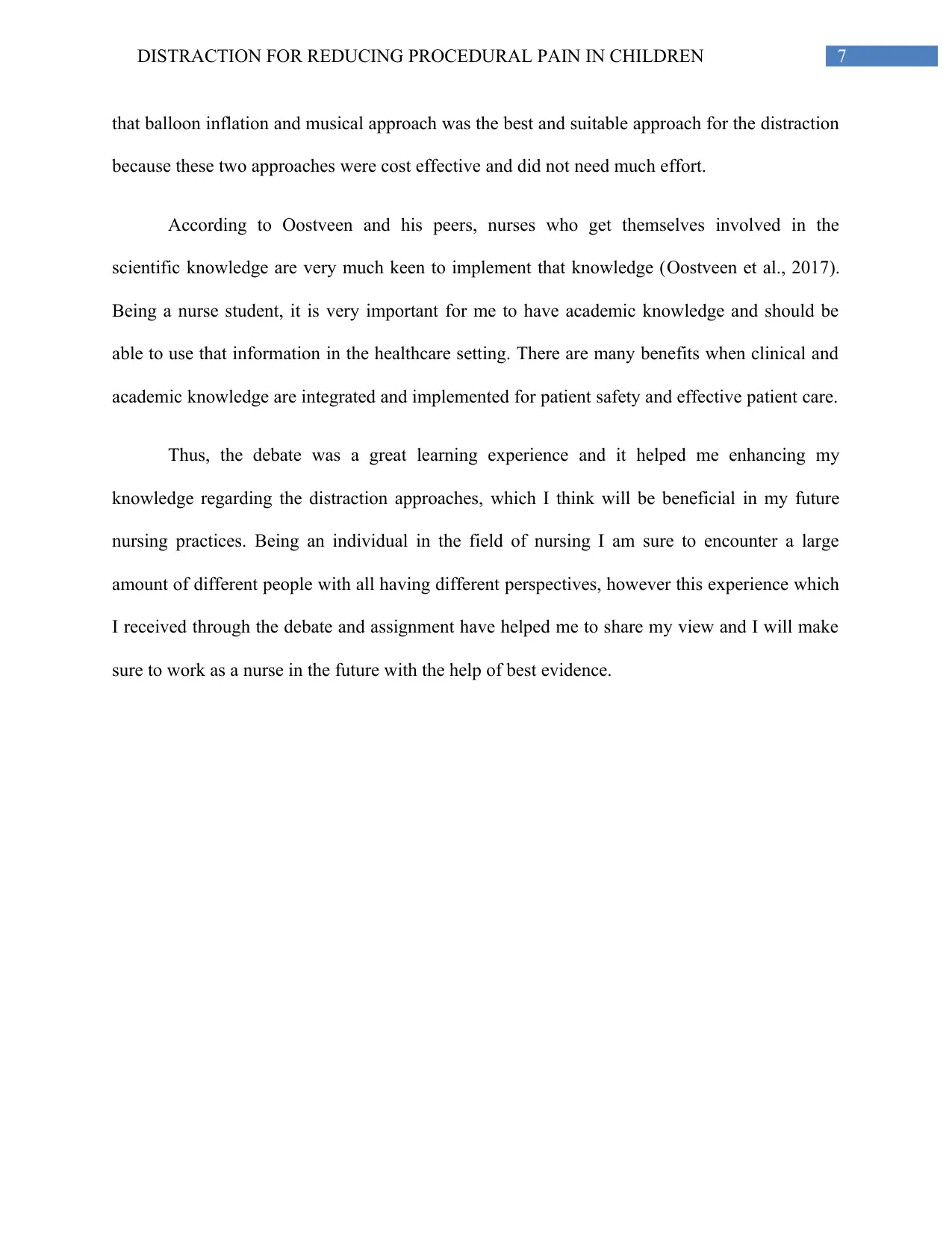
7DISTRACTION FOR REDUCING PROCEDURAL PAIN IN CHILDREN
that balloon inflation and musical approach was the best and suitable approach for the distraction
because these two approaches were cost effective and did not need much effort.
According to Oostveen and his peers, nurses who get themselves involved in the
scientific knowledge are very much keen to implement that knowledge (Oostveen et al., 2017).
Being a nurse student, it is very important for me to have academic knowledge and should be
able to use that information in the healthcare setting. There are many benefits when clinical and
academic knowledge are integrated and implemented for patient safety and effective patient care.
Thus, the debate was a great learning experience and it helped me enhancing my
knowledge regarding the distraction approaches, which I think will be beneficial in my future
nursing practices. Being an individual in the field of nursing I am sure to encounter a large
amount of different people with all having different perspectives, however this experience which
I received through the debate and assignment have helped me to share my view and I will make
sure to work as a nurse in the future with the help of best evidence.
that balloon inflation and musical approach was the best and suitable approach for the distraction
because these two approaches were cost effective and did not need much effort.
According to Oostveen and his peers, nurses who get themselves involved in the
scientific knowledge are very much keen to implement that knowledge (Oostveen et al., 2017).
Being a nurse student, it is very important for me to have academic knowledge and should be
able to use that information in the healthcare setting. There are many benefits when clinical and
academic knowledge are integrated and implemented for patient safety and effective patient care.
Thus, the debate was a great learning experience and it helped me enhancing my
knowledge regarding the distraction approaches, which I think will be beneficial in my future
nursing practices. Being an individual in the field of nursing I am sure to encounter a large
amount of different people with all having different perspectives, however this experience which
I received through the debate and assignment have helped me to share my view and I will make
sure to work as a nurse in the future with the help of best evidence.
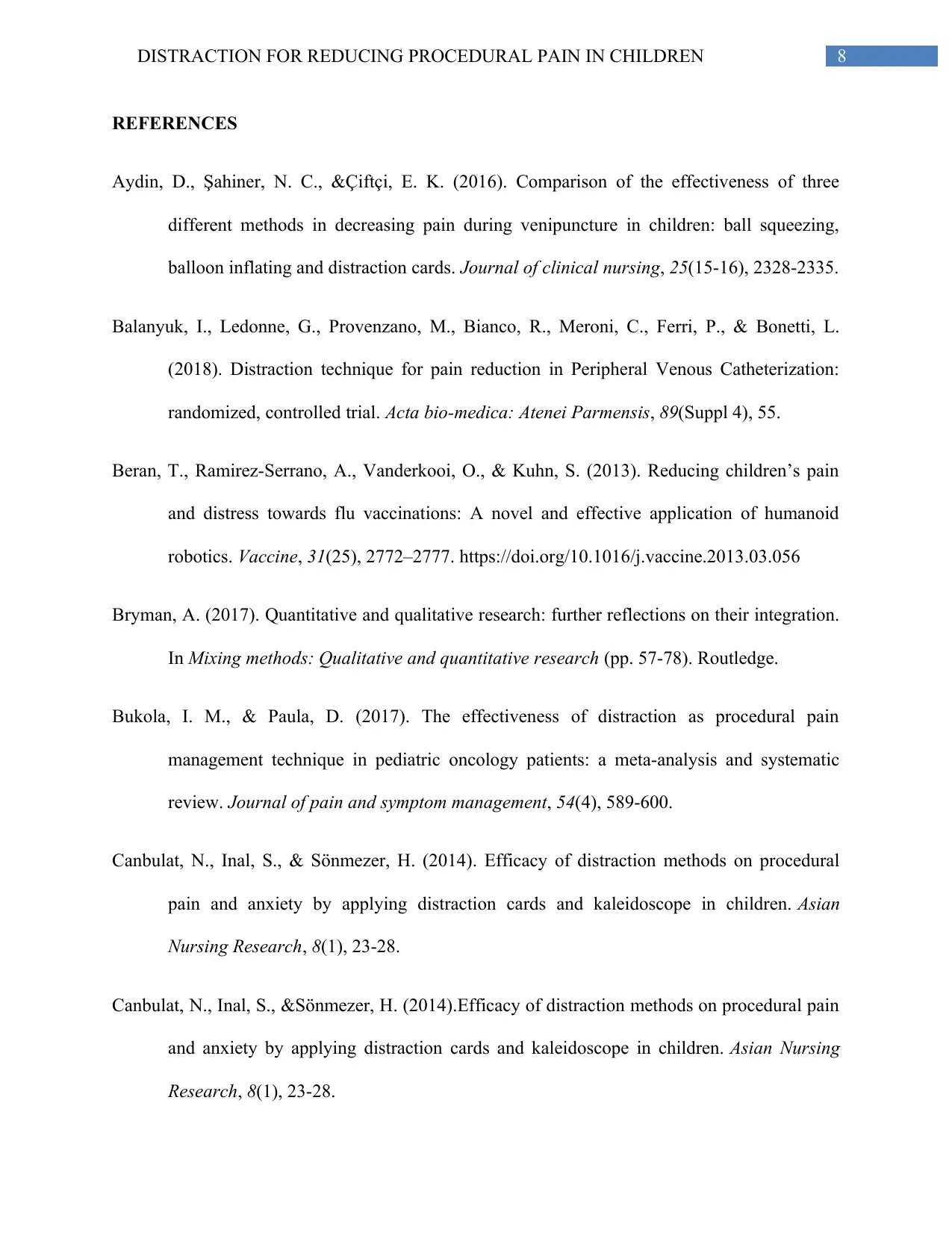
8DISTRACTION FOR REDUCING PROCEDURAL PAIN IN CHILDREN
REFERENCES
Aydin, D., Şahiner, N. C., &Çiftçi, E. K. (2016). Comparison of the effectiveness of three
different methods in decreasing pain during venipuncture in children: ball squeezing,
balloon inflating and distraction cards. Journal of clinical nursing, 25(15-16), 2328-2335.
Balanyuk, I., Ledonne, G., Provenzano, M., Bianco, R., Meroni, C., Ferri, P., & Bonetti, L.
(2018). Distraction technique for pain reduction in Peripheral Venous Catheterization:
randomized, controlled trial. Acta bio-medica: Atenei Parmensis, 89(Suppl 4), 55.
Beran, T., Ramirez-Serrano, A., Vanderkooi, O., & Kuhn, S. (2013). Reducing children’s pain
and distress towards flu vaccinations: A novel and effective application of humanoid
robotics. Vaccine, 31(25), 2772–2777. https://doi.org/10.1016/j.vaccine.2013.03.056
Bryman, A. (2017). Quantitative and qualitative research: further reflections on their integration.
In Mixing methods: Qualitative and quantitative research (pp. 57-78). Routledge.
Bukola, I. M., & Paula, D. (2017). The effectiveness of distraction as procedural pain
management technique in pediatric oncology patients: a meta-analysis and systematic
review. Journal of pain and symptom management, 54(4), 589-600.
Canbulat, N., Inal, S., & Sönmezer, H. (2014). Efficacy of distraction methods on procedural
pain and anxiety by applying distraction cards and kaleidoscope in children. Asian
Nursing Research, 8(1), 23-28.
Canbulat, N., Inal, S., &Sönmezer, H. (2014).Efficacy of distraction methods on procedural pain
and anxiety by applying distraction cards and kaleidoscope in children. Asian Nursing
Research, 8(1), 23-28.
REFERENCES
Aydin, D., Şahiner, N. C., &Çiftçi, E. K. (2016). Comparison of the effectiveness of three
different methods in decreasing pain during venipuncture in children: ball squeezing,
balloon inflating and distraction cards. Journal of clinical nursing, 25(15-16), 2328-2335.
Balanyuk, I., Ledonne, G., Provenzano, M., Bianco, R., Meroni, C., Ferri, P., & Bonetti, L.
(2018). Distraction technique for pain reduction in Peripheral Venous Catheterization:
randomized, controlled trial. Acta bio-medica: Atenei Parmensis, 89(Suppl 4), 55.
Beran, T., Ramirez-Serrano, A., Vanderkooi, O., & Kuhn, S. (2013). Reducing children’s pain
and distress towards flu vaccinations: A novel and effective application of humanoid
robotics. Vaccine, 31(25), 2772–2777. https://doi.org/10.1016/j.vaccine.2013.03.056
Bryman, A. (2017). Quantitative and qualitative research: further reflections on their integration.
In Mixing methods: Qualitative and quantitative research (pp. 57-78). Routledge.
Bukola, I. M., & Paula, D. (2017). The effectiveness of distraction as procedural pain
management technique in pediatric oncology patients: a meta-analysis and systematic
review. Journal of pain and symptom management, 54(4), 589-600.
Canbulat, N., Inal, S., & Sönmezer, H. (2014). Efficacy of distraction methods on procedural
pain and anxiety by applying distraction cards and kaleidoscope in children. Asian
Nursing Research, 8(1), 23-28.
Canbulat, N., Inal, S., &Sönmezer, H. (2014).Efficacy of distraction methods on procedural pain
and anxiety by applying distraction cards and kaleidoscope in children. Asian Nursing
Research, 8(1), 23-28.
⊘ This is a preview!⊘
Do you want full access?
Subscribe today to unlock all pages.

Trusted by 1+ million students worldwide
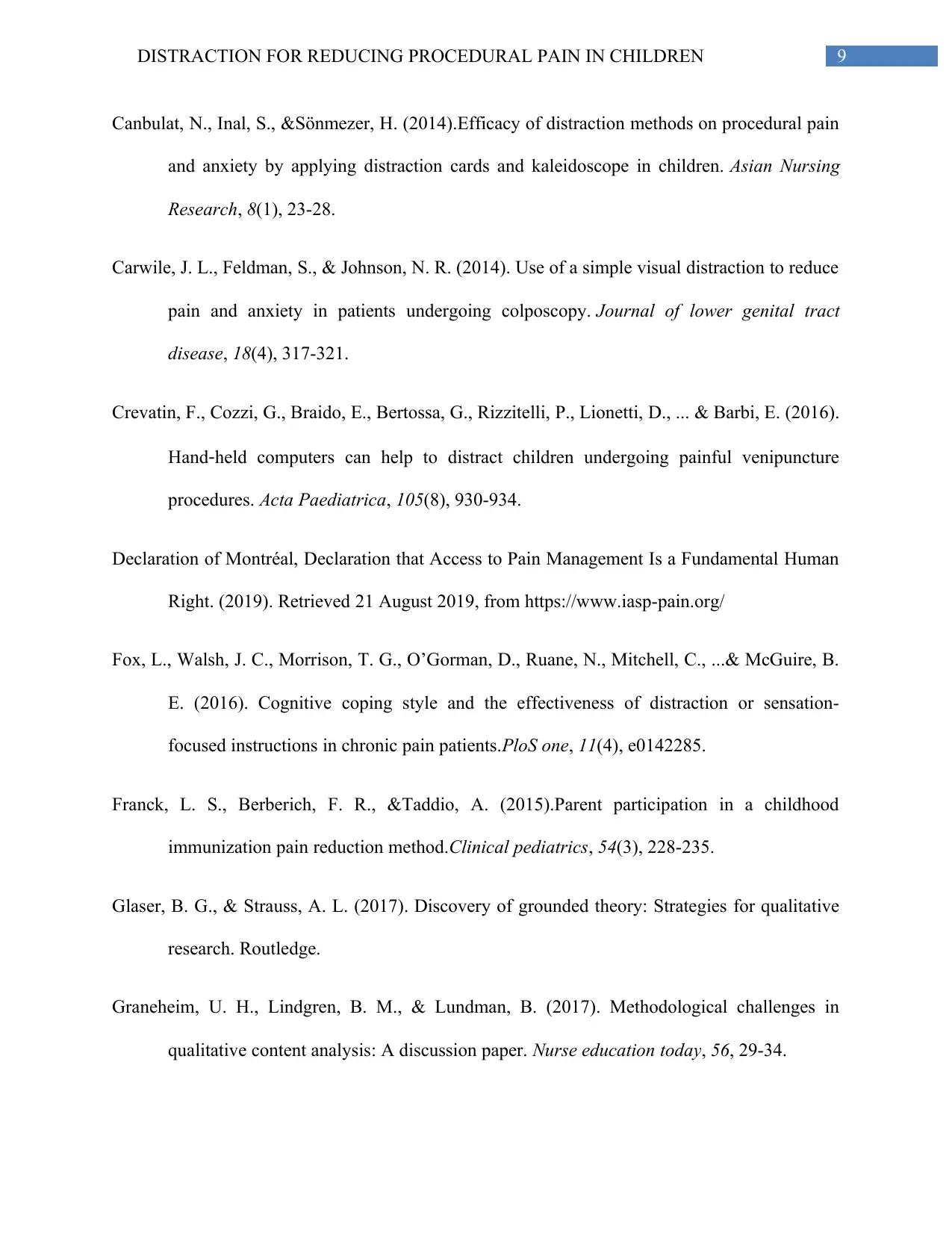
9DISTRACTION FOR REDUCING PROCEDURAL PAIN IN CHILDREN
Canbulat, N., Inal, S., &Sönmezer, H. (2014).Efficacy of distraction methods on procedural pain
and anxiety by applying distraction cards and kaleidoscope in children. Asian Nursing
Research, 8(1), 23-28.
Carwile, J. L., Feldman, S., & Johnson, N. R. (2014). Use of a simple visual distraction to reduce
pain and anxiety in patients undergoing colposcopy. Journal of lower genital tract
disease, 18(4), 317-321.
Crevatin, F., Cozzi, G., Braido, E., Bertossa, G., Rizzitelli, P., Lionetti, D., ... & Barbi, E. (2016).
Hand‐held computers can help to distract children undergoing painful venipuncture
procedures. Acta Paediatrica, 105(8), 930-934.
Declaration of Montréal, Declaration that Access to Pain Management Is a Fundamental Human
Right. (2019). Retrieved 21 August 2019, from https://www.iasp-pain.org/
Fox, L., Walsh, J. C., Morrison, T. G., O’Gorman, D., Ruane, N., Mitchell, C., ...& McGuire, B.
E. (2016). Cognitive coping style and the effectiveness of distraction or sensation-
focused instructions in chronic pain patients.PloS one, 11(4), e0142285.
Franck, L. S., Berberich, F. R., &Taddio, A. (2015).Parent participation in a childhood
immunization pain reduction method.Clinical pediatrics, 54(3), 228-235.
Glaser, B. G., & Strauss, A. L. (2017). Discovery of grounded theory: Strategies for qualitative
research. Routledge.
Graneheim, U. H., Lindgren, B. M., & Lundman, B. (2017). Methodological challenges in
qualitative content analysis: A discussion paper. Nurse education today, 56, 29-34.
Canbulat, N., Inal, S., &Sönmezer, H. (2014).Efficacy of distraction methods on procedural pain
and anxiety by applying distraction cards and kaleidoscope in children. Asian Nursing
Research, 8(1), 23-28.
Carwile, J. L., Feldman, S., & Johnson, N. R. (2014). Use of a simple visual distraction to reduce
pain and anxiety in patients undergoing colposcopy. Journal of lower genital tract
disease, 18(4), 317-321.
Crevatin, F., Cozzi, G., Braido, E., Bertossa, G., Rizzitelli, P., Lionetti, D., ... & Barbi, E. (2016).
Hand‐held computers can help to distract children undergoing painful venipuncture
procedures. Acta Paediatrica, 105(8), 930-934.
Declaration of Montréal, Declaration that Access to Pain Management Is a Fundamental Human
Right. (2019). Retrieved 21 August 2019, from https://www.iasp-pain.org/
Fox, L., Walsh, J. C., Morrison, T. G., O’Gorman, D., Ruane, N., Mitchell, C., ...& McGuire, B.
E. (2016). Cognitive coping style and the effectiveness of distraction or sensation-
focused instructions in chronic pain patients.PloS one, 11(4), e0142285.
Franck, L. S., Berberich, F. R., &Taddio, A. (2015).Parent participation in a childhood
immunization pain reduction method.Clinical pediatrics, 54(3), 228-235.
Glaser, B. G., & Strauss, A. L. (2017). Discovery of grounded theory: Strategies for qualitative
research. Routledge.
Graneheim, U. H., Lindgren, B. M., & Lundman, B. (2017). Methodological challenges in
qualitative content analysis: A discussion paper. Nurse education today, 56, 29-34.
Paraphrase This Document
Need a fresh take? Get an instant paraphrase of this document with our AI Paraphraser
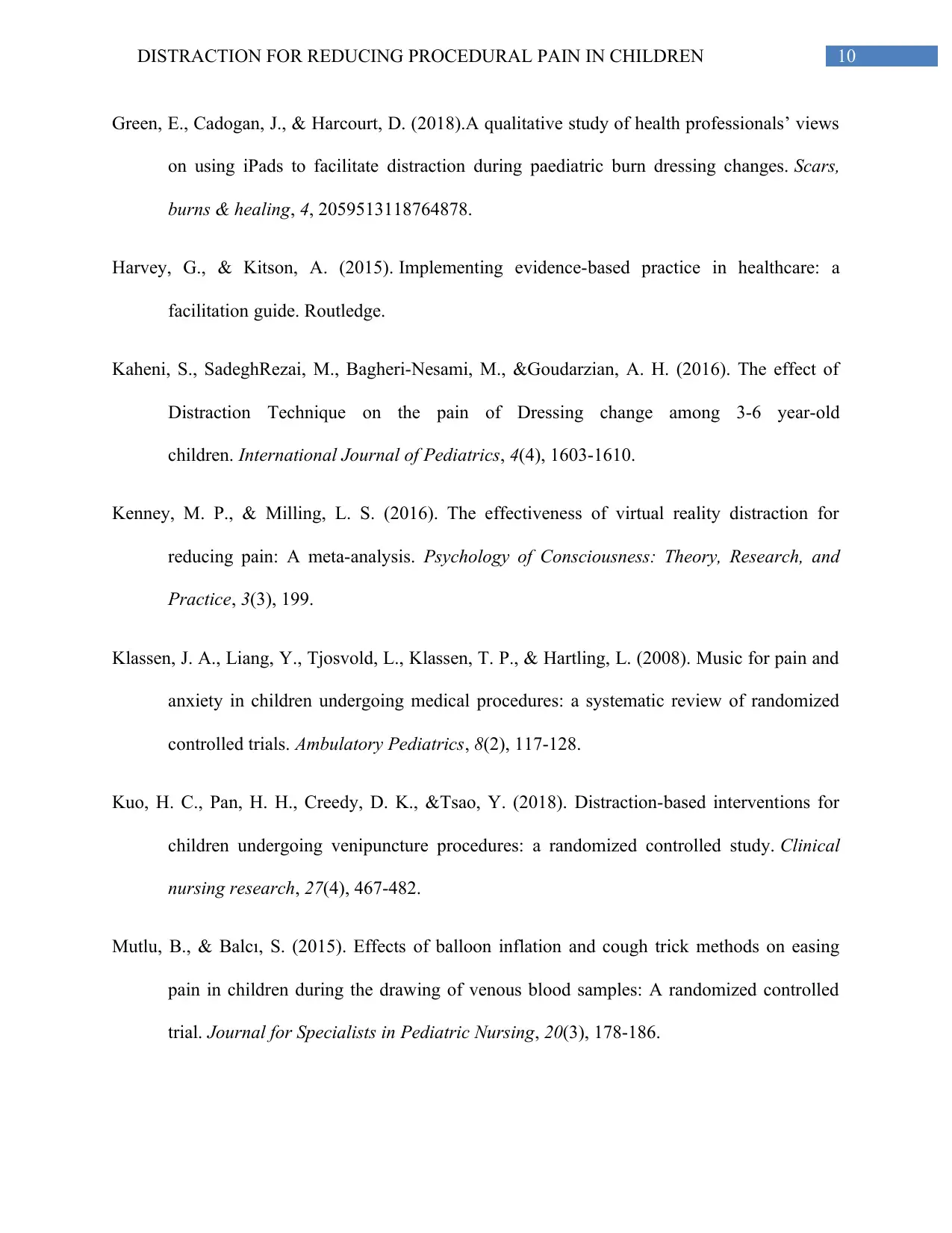
10DISTRACTION FOR REDUCING PROCEDURAL PAIN IN CHILDREN
Green, E., Cadogan, J., & Harcourt, D. (2018).A qualitative study of health professionals’ views
on using iPads to facilitate distraction during paediatric burn dressing changes. Scars,
burns & healing, 4, 2059513118764878.
Harvey, G., & Kitson, A. (2015). Implementing evidence-based practice in healthcare: a
facilitation guide. Routledge.
Kaheni, S., SadeghRezai, M., Bagheri-Nesami, M., &Goudarzian, A. H. (2016). The effect of
Distraction Technique on the pain of Dressing change among 3-6 year-old
children. International Journal of Pediatrics, 4(4), 1603-1610.
Kenney, M. P., & Milling, L. S. (2016). The effectiveness of virtual reality distraction for
reducing pain: A meta-analysis. Psychology of Consciousness: Theory, Research, and
Practice, 3(3), 199.
Klassen, J. A., Liang, Y., Tjosvold, L., Klassen, T. P., & Hartling, L. (2008). Music for pain and
anxiety in children undergoing medical procedures: a systematic review of randomized
controlled trials. Ambulatory Pediatrics, 8(2), 117-128.
Kuo, H. C., Pan, H. H., Creedy, D. K., &Tsao, Y. (2018). Distraction-based interventions for
children undergoing venipuncture procedures: a randomized controlled study. Clinical
nursing research, 27(4), 467-482.
Mutlu, B., & Balcı, S. (2015). Effects of balloon inflation and cough trick methods on easing
pain in children during the drawing of venous blood samples: A randomized controlled
trial. Journal for Specialists in Pediatric Nursing, 20(3), 178-186.
Green, E., Cadogan, J., & Harcourt, D. (2018).A qualitative study of health professionals’ views
on using iPads to facilitate distraction during paediatric burn dressing changes. Scars,
burns & healing, 4, 2059513118764878.
Harvey, G., & Kitson, A. (2015). Implementing evidence-based practice in healthcare: a
facilitation guide. Routledge.
Kaheni, S., SadeghRezai, M., Bagheri-Nesami, M., &Goudarzian, A. H. (2016). The effect of
Distraction Technique on the pain of Dressing change among 3-6 year-old
children. International Journal of Pediatrics, 4(4), 1603-1610.
Kenney, M. P., & Milling, L. S. (2016). The effectiveness of virtual reality distraction for
reducing pain: A meta-analysis. Psychology of Consciousness: Theory, Research, and
Practice, 3(3), 199.
Klassen, J. A., Liang, Y., Tjosvold, L., Klassen, T. P., & Hartling, L. (2008). Music for pain and
anxiety in children undergoing medical procedures: a systematic review of randomized
controlled trials. Ambulatory Pediatrics, 8(2), 117-128.
Kuo, H. C., Pan, H. H., Creedy, D. K., &Tsao, Y. (2018). Distraction-based interventions for
children undergoing venipuncture procedures: a randomized controlled study. Clinical
nursing research, 27(4), 467-482.
Mutlu, B., & Balcı, S. (2015). Effects of balloon inflation and cough trick methods on easing
pain in children during the drawing of venous blood samples: A randomized controlled
trial. Journal for Specialists in Pediatric Nursing, 20(3), 178-186.
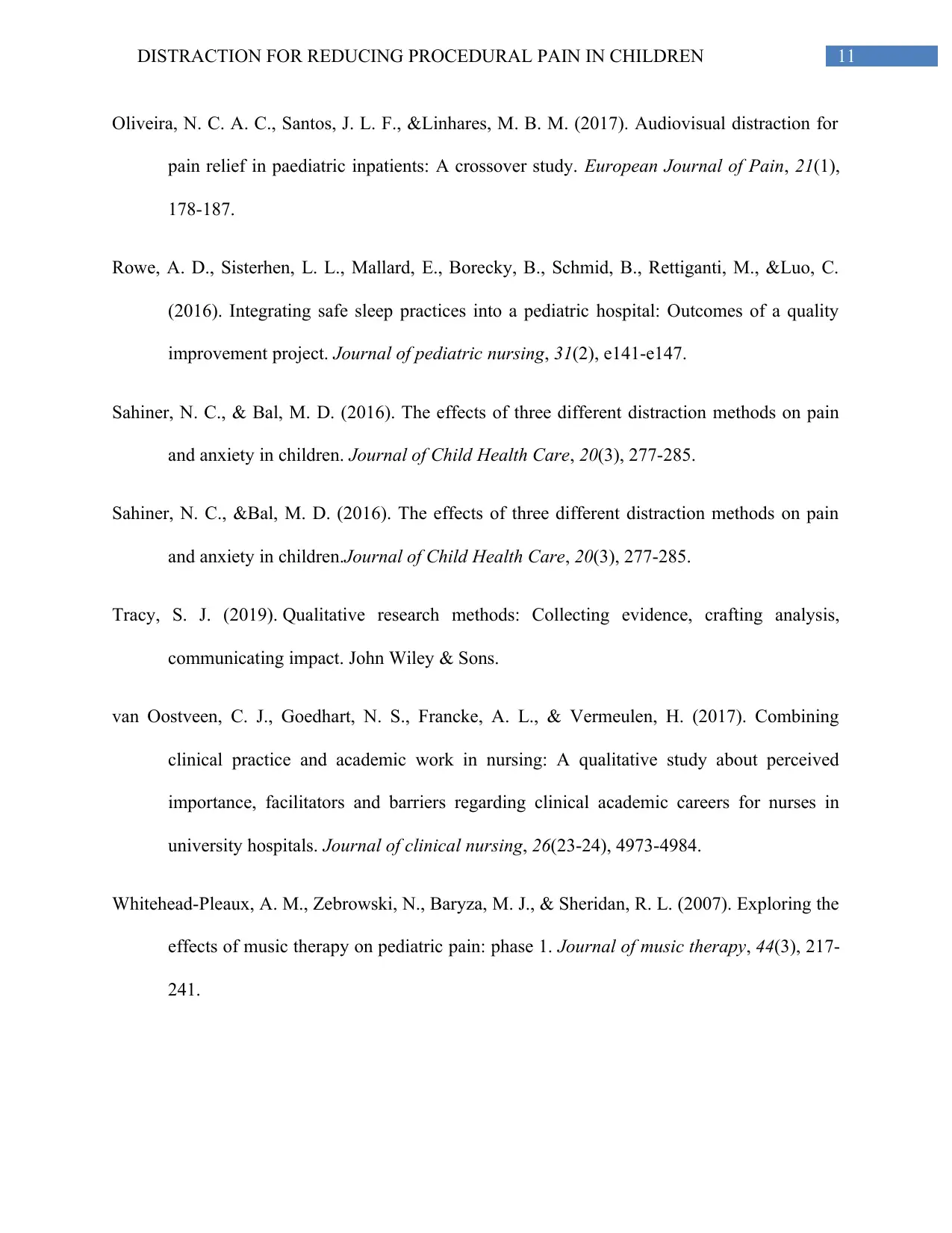
11DISTRACTION FOR REDUCING PROCEDURAL PAIN IN CHILDREN
Oliveira, N. C. A. C., Santos, J. L. F., &Linhares, M. B. M. (2017). Audiovisual distraction for
pain relief in paediatric inpatients: A crossover study. European Journal of Pain, 21(1),
178-187.
Rowe, A. D., Sisterhen, L. L., Mallard, E., Borecky, B., Schmid, B., Rettiganti, M., &Luo, C.
(2016). Integrating safe sleep practices into a pediatric hospital: Outcomes of a quality
improvement project. Journal of pediatric nursing, 31(2), e141-e147.
Sahiner, N. C., & Bal, M. D. (2016). The effects of three different distraction methods on pain
and anxiety in children. Journal of Child Health Care, 20(3), 277-285.
Sahiner, N. C., &Bal, M. D. (2016). The effects of three different distraction methods on pain
and anxiety in children.Journal of Child Health Care, 20(3), 277-285.
Tracy, S. J. (2019). Qualitative research methods: Collecting evidence, crafting analysis,
communicating impact. John Wiley & Sons.
van Oostveen, C. J., Goedhart, N. S., Francke, A. L., & Vermeulen, H. (2017). Combining
clinical practice and academic work in nursing: A qualitative study about perceived
importance, facilitators and barriers regarding clinical academic careers for nurses in
university hospitals. Journal of clinical nursing, 26(23-24), 4973-4984.
Whitehead-Pleaux, A. M., Zebrowski, N., Baryza, M. J., & Sheridan, R. L. (2007). Exploring the
effects of music therapy on pediatric pain: phase 1. Journal of music therapy, 44(3), 217-
241.
Oliveira, N. C. A. C., Santos, J. L. F., &Linhares, M. B. M. (2017). Audiovisual distraction for
pain relief in paediatric inpatients: A crossover study. European Journal of Pain, 21(1),
178-187.
Rowe, A. D., Sisterhen, L. L., Mallard, E., Borecky, B., Schmid, B., Rettiganti, M., &Luo, C.
(2016). Integrating safe sleep practices into a pediatric hospital: Outcomes of a quality
improvement project. Journal of pediatric nursing, 31(2), e141-e147.
Sahiner, N. C., & Bal, M. D. (2016). The effects of three different distraction methods on pain
and anxiety in children. Journal of Child Health Care, 20(3), 277-285.
Sahiner, N. C., &Bal, M. D. (2016). The effects of three different distraction methods on pain
and anxiety in children.Journal of Child Health Care, 20(3), 277-285.
Tracy, S. J. (2019). Qualitative research methods: Collecting evidence, crafting analysis,
communicating impact. John Wiley & Sons.
van Oostveen, C. J., Goedhart, N. S., Francke, A. L., & Vermeulen, H. (2017). Combining
clinical practice and academic work in nursing: A qualitative study about perceived
importance, facilitators and barriers regarding clinical academic careers for nurses in
university hospitals. Journal of clinical nursing, 26(23-24), 4973-4984.
Whitehead-Pleaux, A. M., Zebrowski, N., Baryza, M. J., & Sheridan, R. L. (2007). Exploring the
effects of music therapy on pediatric pain: phase 1. Journal of music therapy, 44(3), 217-
241.
⊘ This is a preview!⊘
Do you want full access?
Subscribe today to unlock all pages.

Trusted by 1+ million students worldwide
1 out of 12
Related Documents
Your All-in-One AI-Powered Toolkit for Academic Success.
+13062052269
info@desklib.com
Available 24*7 on WhatsApp / Email
![[object Object]](/_next/static/media/star-bottom.7253800d.svg)
Unlock your academic potential
Copyright © 2020–2025 A2Z Services. All Rights Reserved. Developed and managed by ZUCOL.





